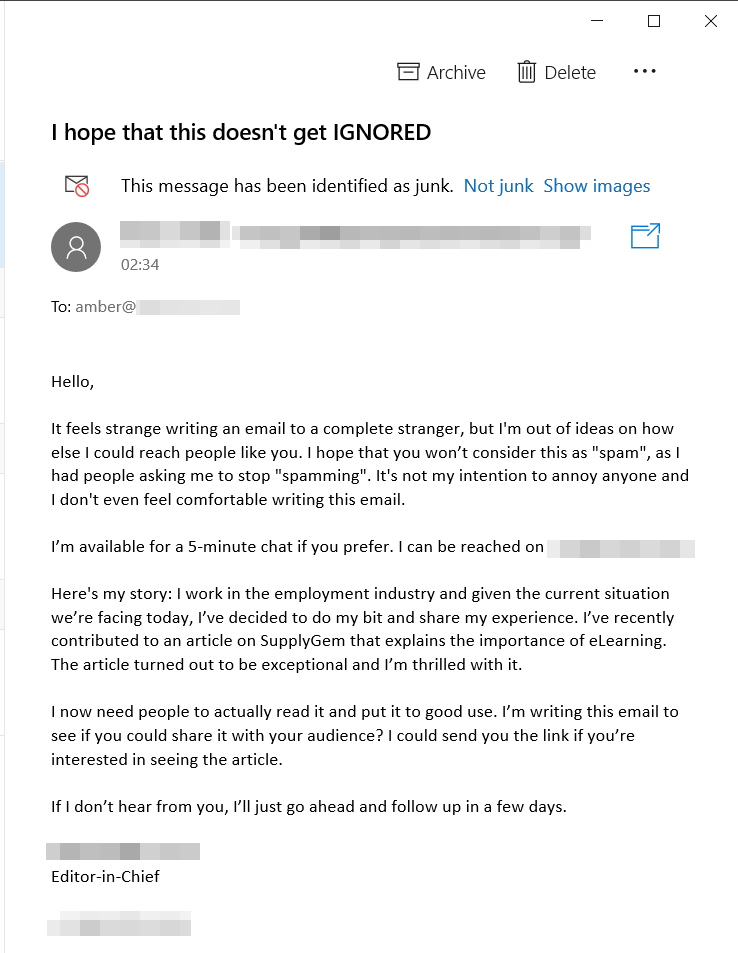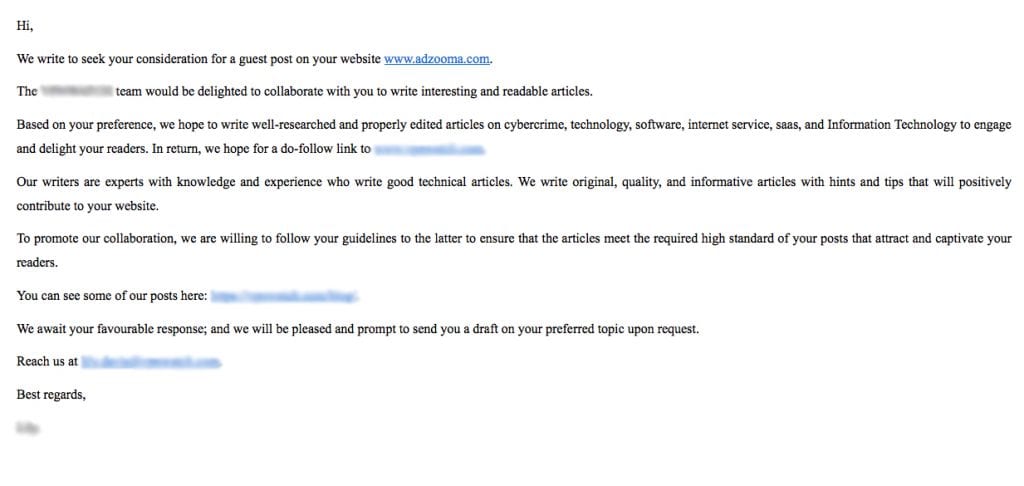Outreach marketing or “outreaching” is the practice of seeking out individuals or organisations who have a shared interest in what you or your company has to offer. It usually involves finding the email addresses of people in your industry and sending them a message asking them to publish your work, link to your article or mention your brand in some way.
The aim of the game? Links.
Links are like marketing currency: they help to improve your online rankings, credibility and brand name. Getting them is a task that is neither quick nor pretty, but it has proven to be a vital part of growing your business.
Many marketers are well-versed in the art of persuasion. But, from the looks of our inbox, it seems there are still people out there aren’t applying that art to outreach. There’s lots to learn from these poor examples, so you can start smashing your outreaching if you’re not already.
Why outreaching is hard
Outreaching is an uphill battle from the start: you can see the summit and the path that will take you there, you just need to put the graft in. The number one obstacle with outreaching is that 90% of the time you’re a cold-caller – they’re not interested, and it’s up to you to change their mind. Whoever you’re contacting is likely super busy and has little time for helping someone out for no gain. It’s all about showing them what’s in it for them straight away.
And, don’t try and pretend you’re not trying to get links. You know you want a link, they know you want a link. There’s no point sugarcoating it as anything else. There are experts who do this kind of thing for a living, so if you want to hand things over, you’ll find them on our marketplace.
1. Make a good impression
There’s being chatty and adding personality, and then there’s straying far from professional. Adopting the right tone is key for incentivising people to help you because you want to show the right qualities. This is particularly important if you’re pitching an article, even more so if you’ve not yet written it, as your email is all they have to go off as an example of your writing style. Yes, they’re not going to be the same tone of voice, but it’s not very professional if you’re talking to them like you’re down the pub, rather than displaying your business prowess.
2. Give examples
It’s important you show value to whoever you’re emailing. An easy (and expected) way of doing this is to link to some examples of your previous work. This is particularly weighty if you’ve been published on recognisable sites.
Far too many emails ping into our inbox asking “if we take Guest Posts?” – yes, that’s why there’s a way to get in touch about it. Don’t waste the first few seconds asking a basic question; fire some smart examples of what you can produce.

3. Don’t appear desperate
Show enthusiasm, but don’t beg it.
So many people get their tone of voice wrong with outreaching. Whilst you’re trying to come across as friendly, lines such as “You’ve read this far? THANK YOU!” and “since you have that kind of tenacity, I’m pretty sure you’ll want to take this forward” sail past flattery and become borderline weird. In fact, the final line feels like we’re at a sermon with an over-enthusiastic preacher expecting us to reply “hell yeah!”
“So, what’s in it for you?
Authentic Information + Interesting Graphics = More Traction [Awesome, right?] 😉
A chance to get up to 94 percent more views on your blog.
A content partner (me) with 60k+ social media followers and 18K+ email subscribers. 🙂
You’ve read this far? THANK YOU! And since you have that kind of tenacity, I’m pretty sure you’ll want to take this forward.
I can’t wait to hear “yes” from you :)”
4. Limit the emojis
Emojis seem to have trickled into emails which can be a nice way of adding a human element to the conversation. It also helps to avoid coming across as blunt. The problem is when overused, it toes into the first point of acting like they’re your mate.
You want to present yourself as a professional, not like you’re sending a text. Too many emojis can be cheesy, and god forbid you press the wrong one. ????
5. Don’t get their back up straight away
Subject lines are really important: 47% of email recipients open an email based on the subject line alone.
This example represents in a nutshell how not to outreach. When you’re trying to get someone to do you a favour, don’t annoy them straight away. Outreach emails notoriously get ignored. In fact, only 8.5% receive any reply at all. People are busy, uninterested and physically don’t have the time to reply to all of them. That’s not bad manners. This example seems to have taken previous experiences to heart, and is carrying that hostility around with them – not the best way to start a working relationship.

Worse still, the writer then goes on to give the game away entirely. They’ve had no luck elsewhere, so this is their last approach. If anything, this makes them less desirable as you think “well if no one else has said yes, what do they know that I don’t?”
The honesty element is nice, but it doesn’t sit right because the subject line has already ruffled feathers. There’s thinking of out of the box to get noticed, and then there’s being noticed for all the wrong reasons.
6. Follow-ups are okay with the right tone
If someone hasn’t replied first time around, it’s good practice to send a follow-up email as it’s proven to get you more replies. They may have honestly missed it and be interested. How you go about sending a second email again speaks volumes of the type of person you are to deal with. You want to prove you’re well-intentioned, polite and efficient.

This follow-up may work for some – it could even be seen as funny. But, it’s much more likely to be taken as a childish email. No, they haven’t been “giving you the silent treatment” like you’re at school, nor are they likely to be sunning themselves on a beach. Humour is so subjective that it’s best to avoid making big gags before you’ve got to know your audience. By being “out there” in your response, you’re narrowing your chances of getting a reply even further.
7. It’s not MySpace
I know email may seem like a dinosaur way of communicating for some, but that doesn’t mean we’re actually back in the early 2000s. Email doesn’t mean we go back to MySpace tactics.

Outreaching isn’t about what you look like, it’s about your talent. Posting a picture of yourself invites judgement straight off the bat (a sad, but true, reality.) You’re also wasting valuable time and highlighting your subtle inexperience – this is what an Author Bio is for!
8. If you’ve used a template, disguise it
Outreach emails are a laborious task, so it’s okay to admit many of us use software such as BuzzStream to manage and send outreach pitches. What makes a huge difference to your response rate, however, is whether it reads like you have or not.
The autofill templates that drag the information of the recipient into the body copy to create a personalised email are well-known and scream laziness. It’s like trying to offer a personalised experience but in a way that actually makes you look more generic. That’s why it’s important to make sure these personalisations don’t look tacked on.
For example, the first line of this email includes a hyperlink to our site… Yes, we’re aware of our own website, thanks for that. Here, a better use of personalisations would have been to insert a name after the ‘Hi’.
You should write your email as though you’re addressing only one person, even if you’re not.

9. Don’t get the name wrong
Someone went to the time and effort of ‘reading’ (scanning) my work, and then worked out how to insert their work into the same theme. Nice. Very personal.
The one problem: I didn’t write that article. My colleague did.

If you’re going to go to all this effort, at least send it to the right person! But, if you make a mistake, it isn’t the worst thing in the world – it’s just an email. Just send a follow-up apologising and make a joke of it, better than losing a contact.
10. Don’t say ‘nice to e-meet you’
Just don’t.
Learn from others’ mistakes
Outreaching is hard and everyone learns on their feet. The people who have been doing it for years will tell you it isn’t a walk in the park – that’s why they charge for their services. If you’re after expert help, check out the Adzooma marketplace for helping finding industry specialists.
As you start getting some replies to your outreaching, you can tweak your approach and improve along the way. That’s true for everyone, so don’t worry about making mistakes. But, hopefully these examples will show you what you shouldn’t be doing, and help make room for what is going to get you those all-important links.




